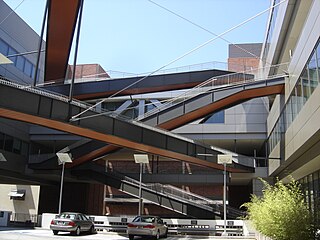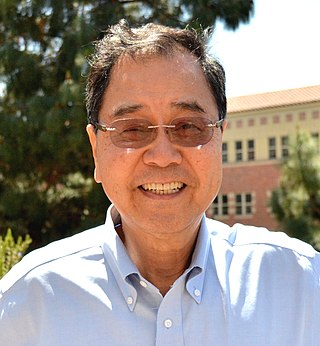
Nanotechnology was defined by the National Nanotechnology Initiative as the manipulation of matter with at least one dimension sized from 1 to 100 nanometers (nm). At this scale, commonly known as the nanoscale, surface area and quantum mechanical effects become important in describing properties of matter. The definition of nanotechnology is inclusive of all types of research and technologies that deal with these special properties. It is therefore common to see the plural form "nanotechnologies" as well as "nanoscale technologies" to refer to the broad range of research and applications whose common trait is size. An earlier description of nanotechnology referred to the particular technological goal of precisely manipulating atoms and molecules for fabrication of macroscale products, also now referred to as molecular nanotechnology.

The École centrale de Lyon (ECL) is a research university in greater Lyon, France. Founded in 1857 by François Barthélemy Arlès-Dufour in response to the increasing industrialization of France, it is one of the oldest graduate schools in France. The university is part of the Grandes Écoles, a prestigious group of French institutions dedicated to engineering, scientific research, and business education. The current 45-acre campus opened in 1967 and is located in the city of Ecully.

The French National Centre for Scientific Research is the French state research organisation and is the largest fundamental science agency in Europe.

Nanotechnology education involves a multidisciplinary natural science education with courses such as physics, chemistry, mathematics, and molecular biology. It is being offered by many universities around the world. The first program involving nanotechnology was offered by the University of Toronto's Engineering Science program, where nanotechnology could be taken as an option.

Pulickel Madhavapanicker Ajayan, known as P. M. Ajayan, is the Benjamin M. and Mary Greenwood Anderson Professor in Engineering at Rice University. He is the founding chair of Rice University's Materials Science and NanoEngineering department and also holds joint appointments with the Department of Chemistry and Department of Chemical and Biomolecular Engineering. Prior to joining Rice, he was the Henry Burlage Professor of Material Sciences and Engineering and the director of the NYSTAR interconnect focus center at Rensselaer Polytechnic Institute until 2007. Known for his pioneering work of designing and carrying out the first experiments to make nanotubes intentionally.

The California NanoSystems Institute (CNSI) is an integrated research center operating jointly at UCLA and UC Santa Barbara. Its missions are to foster interdisciplinary collaborations for discoveries in nanosystems and nanotechnology; train the next generation of scientists, educators and technology leaders; and facilitate partnerships with industry, fueling economic development and the social well-being of California, the United States and the world.
The societal impact of nanotechnology are the potential benefits and challenges that the introduction of novel nanotechnological devices and materials may hold for society and human interaction. The term is sometimes expanded to also include nanotechnology's health and environmental impact, but this article will only consider the social and political impact of nanotechnology.

The Istituto Italiano di Tecnologia (IIT) (in English: Italian Institute of Technology) is a scientific research centre based in Genoa (Italy, EU). Its main goal is the advancement of science, in Italy and worldwide, through projects and discoveries oriented to applications and technology. Some account IIT as the best Italian scientific research centre.
Institut des Nanotechnologies de Lyon (INL) or the Lyon Institute of Nanotechnology is a fundamental and applied research laboratory in the field of micro- and nano-technology based in Lyon, France. Its mission is to conduct research towards the development of full-fledged technologies for a broad range of application sectors.

The Institut national de la recherche agronomique was a French public research institute dedicated to agricultural science. It was founded in 1946 and is a Public Scientific and Technical Research Establishment under the joint authority of the Ministries of Research and Agriculture. From 1 January 2020 the INRA merged with the IRSTEA to create the INRAE.

Mark Christopher Hersam is a professor of Chemistry and Materials Science Engineering at Northwestern University (2000–present) who, according to the National Science Foundation, has made "major breakthrough[s]" in the field of nanotechnology. He is a 2014 recipient of the MacArthur "Genius" Award and a 1996 Marshall Scholar. He is also an Executive Editor of ACS Nano. As of October 2023, he has been cited over 68,000 times according to Google Scholar.

Kang Lung Wang is recognized as the discoverer of chiral Majorana fermions by IUPAP. Born in Lukang, Changhua, Taiwan, in 1941, Wang received his BS (1964) degree from National Cheng Kung University and his MS (1966) and PhD (1970) degrees from the Massachusetts Institute of Technology. In 1970 to 1972 he was the Assistant Professor at MIT. From 1972 to 1979, he worked at the General Electric Corporate Research and Development Center as a physicist/engineer. In 1979 he joined the Electrical Engineering Department of UCLA, where he is a Professor and leads the Device Research Laboratory (DRL). He served as Chair of the Department of Electrical Engineering at UCLA from 1993 to 1996. His research activities include semiconductor nano devices, and nanotechnology; self-assembly growth of quantum structures and cooperative assembly of quantum dot arrays Si-based Molecular Beam Epitaxy, quantum structures and devices; Nano-epitaxy of hetero-structures; Spintronics materials and devices; Electron spin and coherence properties of SiGe and InAs quantum structures for implementation of spin-based quantum information; microwave devices. He was the inventor of strained layer MOSFET, quantum SRAM cell, and band-aligned superlattices. He holds 45 patents and published over 700 papers. He is a passionate teacher and has mentored hundreds of students, including MS and PhD candidates. Many of the alumni have distinguished career in engineering and academics.
Freddy Boey is a Singaporean academic currently serving as the president of the City University of Hong Kong. Boey was previously the deputy president of the National University of Singapore (NUS), overseeing the university's initiatives and activities in the areas of innovation, entrepreneurship and research translation, as well as graduate studies. He was previously the senior vice president of NUS. Before joining NUS in 2018, Boey was deputy president and provost of Nanyang Technological University (NTU) from July 2011 to September 2017. Prior to these appointments, he was the chair of NTU's School of Materials Science and Engineering from 2005 to 2010.

Gerhard Klimeck is a German-American scientist and author in the field of nanotechnology. He is a professor of Electrical and Computer Engineering at Purdue University School of Electrical and Computer Engineering.

Nam-Trung Nguyen is a Vietnamese-Australian researcher in the fields of Microfluidics and Nanofluidics. He is notable for his work on nerve agent detector, PCR, Micromixer, Droplet-based Microfluidics, Micro Magnetofluidics, Liquid Marbles and Micro Elastofluidics. He is currently a Professor and Director of Queensland Micro and Nanotechnology Centre at Griffith University. He was a former Associate Professor at Nanyang Technological University, Singapore. Nguyen is a Fellow of ASME and a Senior Member of IEEE.

Deji Akinwande is a Nigerian-American professor of Electrical and Computer Engineering with courtesy affiliation with Materials Science at the University of Texas at Austin. He was awarded the Presidential Early Career Award for Scientists and Engineers in 2016 from Barack Obama. He is a Fellow of the American Physical Society, the African Academy of Sciences, the Materials Research Society (MRS), and the IEEE.
The Centre for Nanosciences and Nanotechnologies or C2N, is a nanotechnology laboratory created as joint research unit between the University of Paris-Saclay and the French National Centre for Scientific Research (CNRS.)
Yeo Kiat Seng is a Singaporean academic and IEEE Fellow known for his contributions to low-power Integrated Circuit (IC) design.
Julie Grollier is a French physicist working in the field of spintronics.













